| Federal Building 1937 317 First Street |
[close] |
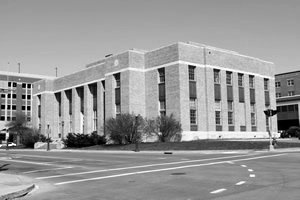 Built for the post office, this building was also home to Wausau's elected officials and several government agencies. On the second floor was the U.S. Marshall's office, complete with a single holding cell for people awaiting trial in the federal courtroom down the hall. The FBI office, protected by a bullet proof door, was also on the second floor. At ground level of this Art Moderne structure designed by Louis A. Simon of the U.S. Office of Supervising Architects in Washington D.C. and Oppenhamer and Obel of Wausau and Green bay was the mail center. Here patrons could view an expressionist mural by Gerrit Sinclair. Distinct marble trim clad with ornament also decorates the area. Below, in the basement, was the office of the IRS. Since 1998, the building has been vacant. Built for the post office, this building was also home to Wausau's elected officials and several government agencies. On the second floor was the U.S. Marshall's office, complete with a single holding cell for people awaiting trial in the federal courtroom down the hall. The FBI office, protected by a bullet proof door, was also on the second floor. At ground level of this Art Moderne structure designed by Louis A. Simon of the U.S. Office of Supervising Architects in Washington D.C. and Oppenhamer and Obel of Wausau and Green bay was the mail center. Here patrons could view an expressionist mural by Gerrit Sinclair. Distinct marble trim clad with ornament also decorates the area. Below, in the basement, was the office of the IRS. Since 1998, the building has been vacant. |
|
| Marathon County Public Library 1907 400 First Street |
[close] | |||||
| The first city owned public library opened in 1907 as a result of community pressure, a gift of $25,000 from Andrew Carnegie, and land donated by Walter Alexander. In April of 1905, Architect George W. Maher submitted plans for the structure to be built by contractors Miller and Krause.
The building was Neo-Classical in design, but several additions significantly modified the original form. A sympathetic second story auditorium designed
by architects Oppenhamer and Obel of Wausau and Green Bay expanded
the north face in 1928. However, the 1965-68 modifications severely
diminished the library's architectural integrity. In 1995, a new library to meet new demands was built, and a small balustrade on the First Street face is all that remains of the1907 building. To the south of the library is McIndoe Park. Donated by Walter Alexander, it is a tribute to the "Father of Wausau," Walter McIndoe. |
||||||
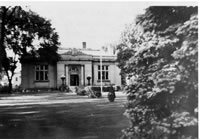 Marathon County Public Library 1907 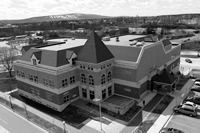 Marathon County Public Library 2010 |
||||||
| Bee Hive Store 1884 318-324 Third Street |
[close] |
 The Heinemann brothers built this three story brick structure and named it the Bee Hive store. On January 21, 1886, electric light first brightened the city of Wausau in this building. The Wausau Pilot reported, "Third Street, in the vicinity of Heinemann Brother's store, is as light as day, made so from the ten electric lights in front of that mammoth establishment." In 1895 Charles and Samuel Livingston purchased the business and operated it through 1904 when they relocated down the street to what is now Washington Square. The Bee Hive building's round headed windows on the third story, rectangular windows on the second floor, and metal cornice at the entrance all indicate a Commercial Vernacular style. The first story has been significantly modified, however. Since 1904 there have been a variety of retail stores and offices in the building. The Heinemann brothers built this three story brick structure and named it the Bee Hive store. On January 21, 1886, electric light first brightened the city of Wausau in this building. The Wausau Pilot reported, "Third Street, in the vicinity of Heinemann Brother's store, is as light as day, made so from the ten electric lights in front of that mammoth establishment." In 1895 Charles and Samuel Livingston purchased the business and operated it through 1904 when they relocated down the street to what is now Washington Square. The Bee Hive building's round headed windows on the third story, rectangular windows on the second floor, and metal cornice at the entrance all indicate a Commercial Vernacular style. The first story has been significantly modified, however. Since 1904 there have been a variety of retail stores and offices in the building. |
|
| Livingston Winkleman Building 1904 300 Third Street |
[close] |
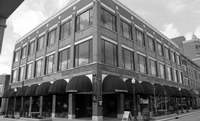 Jacob Kolter's Music Hall was first built here in 1869. A place for concerts and theatre acts, the hall was the destination for performance enthusiasts until 1883 when the Wausau Opera House opened. By 1895 attendance at the music hall had declined so drastically that the structure was demolished. Phillip Dean designed a two story Commercial style structure at this location for Samuel and Charles Livingston's department store in 1904. The business changed ownership in 1911 when Samuel Winkleman arrived from Michigan and purchased it from the Livingston's, giving it his name. As Wausau grew, so did the store. Samuel's son Cassius added a third story with a band of chevrons and W's for Winkleman in 1936. The building remained property of their family until 1970, when the Johnson Hills store purchased it, and significantly altered the interior and exterior appearance. A 1983 renovation restored the original integrity of the building now called Washington Square. Jacob Kolter's Music Hall was first built here in 1869. A place for concerts and theatre acts, the hall was the destination for performance enthusiasts until 1883 when the Wausau Opera House opened. By 1895 attendance at the music hall had declined so drastically that the structure was demolished. Phillip Dean designed a two story Commercial style structure at this location for Samuel and Charles Livingston's department store in 1904. The business changed ownership in 1911 when Samuel Winkleman arrived from Michigan and purchased it from the Livingston's, giving it his name. As Wausau grew, so did the store. Samuel's son Cassius added a third story with a band of chevrons and W's for Winkleman in 1936. The building remained property of their family until 1970, when the Johnson Hills store purchased it, and significantly altered the interior and exterior appearance. A 1983 renovation restored the original integrity of the building now called Washington Square. |
|
| Chicago and Northwestern Depot 1899 209 West Washington Street |
[close] |
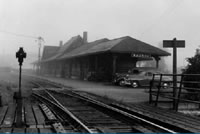 The first railroad for passenger and freight use reached Wausau in 1874. The second, in 1880, was the Milwaukee, Lakeshore and Western Railroad which served sawmills on Clark Island, the first settlement in the Wausau area. Two years later, the Chicago and Northwestern railroad acquired that line and took over operations. To facilitate the needs of passengers and lumber companies the Chicago and Northwestern Depot was built in 1899. Designed by Chicago architect G.A. Johnson, this brick building exhibits a double pitched hip roof with canopied extensions, rounded top windows, and gables decorate the center which all lend to a Utilitarian Commercial citation. As railway use declined, the C&NW railway discontinued service in 1954, and the train depot became the city bus depot the same year. It provided bus service until 1966, and since that time the depot has been home to a restaurant and a number of business offices.
The first railroad for passenger and freight use reached Wausau in 1874. The second, in 1880, was the Milwaukee, Lakeshore and Western Railroad which served sawmills on Clark Island, the first settlement in the Wausau area. Two years later, the Chicago and Northwestern railroad acquired that line and took over operations. To facilitate the needs of passengers and lumber companies the Chicago and Northwestern Depot was built in 1899. Designed by Chicago architect G.A. Johnson, this brick building exhibits a double pitched hip roof with canopied extensions, rounded top windows, and gables decorate the center which all lend to a Utilitarian Commercial citation. As railway use declined, the C&NW railway discontinued service in 1954, and the train depot became the city bus depot the same year. It provided bus service until 1966, and since that time the depot has been home to a restaurant and a number of business offices.
|
|
| Wisconsin Public Service Building 1941-1942 330 Fourth Street |
[close] |
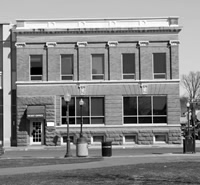 Architects Oppenhamer and Obel of Wausau and Green Bay drew up the plans for
this building for the local utility firm in 1941. Designed with trademark Art
Deco style motifs, it is an excellent example of that style of archicture which
was popularized in the late 1920’s. The fluted pilasters and geometrical
facings of limestone and glass block provide the building with a tame, but
futuristic look often associated with the machine age of the two world wars.
From1929 – 1941 the American Legion club house was situated at this site.
The building is currently occupied by the engineering firm of Becher-Hoppe.
Architects Oppenhamer and Obel of Wausau and Green Bay drew up the plans for
this building for the local utility firm in 1941. Designed with trademark Art
Deco style motifs, it is an excellent example of that style of archicture which
was popularized in the late 1920’s. The fluted pilasters and geometrical
facings of limestone and glass block provide the building with a tame, but
futuristic look often associated with the machine age of the two world wars.
From1929 – 1941 the American Legion club house was situated at this site.
The building is currently occupied by the engineering firm of Becher-Hoppe. |
|
| Wausau Gas Light and Coke Company 1901 401 Fourth Street |
[close] |
| From 1901 - 1925 the Wausau Gas Light and Coke Company provided service out of this facility. Established in 1884, this firm provided gas for the city's initial street and interior light systems. Within ten years however, electricity powered the street lights, and by the mid 1920's electricity was standard in most indoor applications as well. Phillip Dean designed the building, and like the other structures on the block, it is a fine example of the Neo-Classical revival style. The ionic pilasters, denticulated cornice, decorative emblems, and the parapet at the roofline all contribute to the classical citation. Contractor John Gritzmacher incorporated both brick and Wausau granite into the structure's exterior facings. After1925 the building was occupied by law firms and businesses. It is currently owned by the Performing Arts Foundation. | |
| Grand Theatre 1927 427 Fourth Street |
[close] |
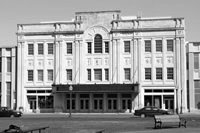 Pictured here is Wausau's pride and joy: The Grand Theatre. Since its debut film "Dress Parade" on Thanksgiving Day 1927, the Grand has been alive with entertainment. Similar to other theatres of the era, this magnificent Neo-Classical revival structure is heavily clad in ornament including colossal pilasters, Adamesque urns and garland, a Palladian window, and a parapet at the roofline. The triumphant exterior pays compliment to the elegant interior which accommodates an audience of over one thousand. Designed by architects Oppenhammer and Obel of Wausau and Green Bay, it was built due to the growing interest in vaudeville productions in the 1920's and replaced the former Grand Opera House of 1900 at the same location. In 1987 the Grand underwent a community sponsored restoration to maintain its grandeur which attracts Broadway shows, concerts, and local productions. From the beginning, the Grand Theatre has maintained the motto under which it was constructed: "The best is none too good for Wausau."
Pictured here is Wausau's pride and joy: The Grand Theatre. Since its debut film "Dress Parade" on Thanksgiving Day 1927, the Grand has been alive with entertainment. Similar to other theatres of the era, this magnificent Neo-Classical revival structure is heavily clad in ornament including colossal pilasters, Adamesque urns and garland, a Palladian window, and a parapet at the roofline. The triumphant exterior pays compliment to the elegant interior which accommodates an audience of over one thousand. Designed by architects Oppenhammer and Obel of Wausau and Green Bay, it was built due to the growing interest in vaudeville productions in the 1920's and replaced the former Grand Opera House of 1900 at the same location. In 1987 the Grand underwent a community sponsored restoration to maintain its grandeur which attracts Broadway shows, concerts, and local productions. From the beginning, the Grand Theatre has maintained the motto under which it was constructed: "The best is none too good for Wausau."
| |
| Courthouse Square |
[close] |
| Courthouse square was purchased in 1853 for $100 from Walter McIndoe for the erection of a county office building and was home to the area's courthouses for over a century. The first structure built on this parcel was completed in 1854, and replaced the original county clerk's office of 1851. The new county office building, like the former, failed to meet the needs of Wausau's rapid settlement. The building was razed and a third courthouse was completed in 1868. Built as a two story Greek Revival frame structure, it was the first to include a courtroom. In 1892 a significantly larger courthouse was built. Designed by Milwaukee architect H.C. Koch, it was of the Richardson Romanesque style. Contractor John Miller, using Marathon County brick and granite completed the courthouse for $65,000. Judge Louis Marchetti wrote of this building that it "far surpasses anything previously done in that line in former years." Indeed, the courthouse not only represented a new era of architectural ingenuity in Wausau, but also embodied the essence of Wausau's growing vitality. In 1955, the current functional courthouse situated at 500 Forest Street was built and in that same year the 1892 structure was removed from courthouse square for a block of retail stores. The square was cleared in 2002 | |
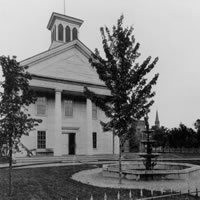 Marathon County Courthouse 1868 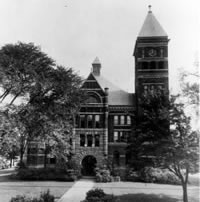 Marathon County Courthouse 1892 |
|
| Wisconsin Valley Trust Company 1908 427 Fourth Street |
[close] |
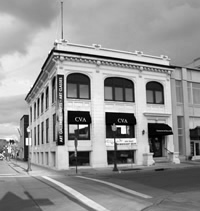 Wausau Attorneys Andrew Kruetzer, Claire Bird, and Marvin Rosenberry had this structure built for their enterprise: Wisconsin Valley Trust Company. Designed by architects Van Ryn and De Gelleke of Milwaukee, this Neo-Classical Revival building flaunts arched windows, a cornice decorated with dentils, and a parapet at the roofline. Considered very elaborate, it was toured by some 2000 Wausau residents upon its completion. The firm dissolved in 1938, after which the building was leased by law firms and insurance companies until 1972 when the Wausau Area Chamber of Commerce moved in. The Grand Theatre Foundation purchased it in 1988 and since that time it has been home to the Center for Visual Arts.
Wausau Attorneys Andrew Kruetzer, Claire Bird, and Marvin Rosenberry had this structure built for their enterprise: Wisconsin Valley Trust Company. Designed by architects Van Ryn and De Gelleke of Milwaukee, this Neo-Classical Revival building flaunts arched windows, a cornice decorated with dentils, and a parapet at the roofline. Considered very elaborate, it was toured by some 2000 Wausau residents upon its completion. The firm dissolved in 1938, after which the building was leased by law firms and insurance companies until 1972 when the Wausau Area Chamber of Commerce moved in. The Grand Theatre Foundation purchased it in 1988 and since that time it has been home to the Center for Visual Arts.
| |
| Marathon County Bank;
1874, 1892, 1925;
402 Third Street |
[close] |
| The banking business emerged in the city during the late 19th and early 20th centuries to facilitate financial transactions in a time of growing prosperity and commerce. The first institution, the Bank of the Interior, opened in 1858 and merged with the newly formed Marathon County Bank in 1874 in a solid brick building at 402 Third Street. A new bank building constructed of Marathon County Red Granite was built here in 1892 and served until 1925 when the current neo classical style structure was completed. The Wausau Pilot reported that year, "Finished in white Bedford stone with massive columns, in conformance with the latest ideas of modern bank construction; the architectural design presents both an imposing and substantial appearance." Inside, a vault with double combination locks, triple timed locks, and wired alarms protected the patrons' interests. The bank merged with American National Bank and moved to the 500 block of Third Street. From 1929-1982 Mayer's shoe store occupied the building after which a variety of stores and offices moved in. | |
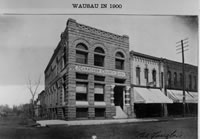 Marathon County Bank 1892 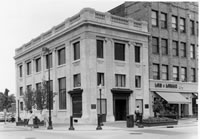 Marathon County Bank 1925 | |
| Mayer Lotz Building 1929-1930 408-410 Third Street |
[close] |
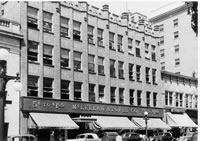 Business partners Charles B. Mayer, a local shoe store owner, and Carl Lotz of Lotz Sand and Gravel built this structure in 1929 strictly as a real estate investment. Designed in the Chicago commercial style, it features a touch of Art Deco near the roofline, geometric capitals and engraved columns. McClellan's Five and Dime store leased the building from Mayer and Lotz through 1959, and since that time it has been occupied by various retail businesses, offices, and restaurants. Prior to this building, the location was home to the offices of physicians, the county coroner, and clothing stores.
Business partners Charles B. Mayer, a local shoe store owner, and Carl Lotz of Lotz Sand and Gravel built this structure in 1929 strictly as a real estate investment. Designed in the Chicago commercial style, it features a touch of Art Deco near the roofline, geometric capitals and engraved columns. McClellan's Five and Dime store leased the building from Mayer and Lotz through 1959, and since that time it has been occupied by various retail businesses, offices, and restaurants. Prior to this building, the location was home to the offices of physicians, the county coroner, and clothing stores.
| |
| Hotel Wausau 1924 221 Scott Street |
[close] |
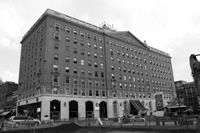 Chicago Architects Holabird and Roche, important in the development of the skyscraper form, drew the plans for this eight story brick covered Classical Revival style hotel. It includes arcaded windows on the ground floor and a pediment at the roofline with urns, balustrades, and a "W" for Wausau. In the 1970's the hotel was turned into residential units, shops, and a restaurant. The original chandelier still hangs inside the ballroom. At this location, built in the early 1880's by George Bellis, and later demolished was the Hotel Bellis.
Chicago Architects Holabird and Roche, important in the development of the skyscraper form, drew the plans for this eight story brick covered Classical Revival style hotel. It includes arcaded windows on the ground floor and a pediment at the roofline with urns, balustrades, and a "W" for Wausau. In the 1970's the hotel was turned into residential units, shops, and a restaurant. The original chandelier still hangs inside the ballroom. At this location, built in the early 1880's by George Bellis, and later demolished was the Hotel Bellis.
| |
| Pilot Building 1901 324 Scott Street |
[close] |
 Valentine Ringle began publication of Wausau's second newspaper in 1865, a weekly called the Wisconsin River Pilot. Eugene B. Thayer purchased the firm in 1884 and renamed it the Wausau Pilot Review, later the Wausau Pilot. As early as 1894 the paper was located at 324 Scott Street housed in a small wood framed structure. However, in 1901 Architect Phillip Dean designed a new commercial style building with an arcaded central bay for the publication at the same location. By 1920, Thayer's son, Eugene Jr. was conducting the operations of the paper, and under his management it was known for the frequent publication of his personal recollections of Wausau's early years.
The J.C. Penney store moved into the first floor beneath the Pilot in 1915. Printing came to a stop in 1940, and by 1961 Shepherd & Schaller Sports owned the structure.
Valentine Ringle began publication of Wausau's second newspaper in 1865, a weekly called the Wisconsin River Pilot. Eugene B. Thayer purchased the firm in 1884 and renamed it the Wausau Pilot Review, later the Wausau Pilot. As early as 1894 the paper was located at 324 Scott Street housed in a small wood framed structure. However, in 1901 Architect Phillip Dean designed a new commercial style building with an arcaded central bay for the publication at the same location. By 1920, Thayer's son, Eugene Jr. was conducting the operations of the paper, and under his management it was known for the frequent publication of his personal recollections of Wausau's early years.
The J.C. Penney store moved into the first floor beneath the Pilot in 1915. Printing came to a stop in 1940, and by 1961 Shepherd & Schaller Sports owned the structure.
| |
| McCrossen Block 1875 501 Third Street |
[close] |
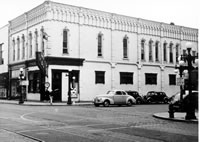 Wausau's oldest remaining building was home to James McCrossen's general store from 1875-1892. Originally built as a brick Italianate Commercial structure, a 1950 fire destroyed much of the original integrity. One of the first murders in the city is said to have occurred on the second floor of this building in the office of Dr. E.L. Hagel, a dentist from Stevens Point. At this time there was only one dentist in Wausau, Dr. J.C. Bennet. When Hagel arrived in 1880, Bennet promptly rid himself of the unwanted competition by ending Hagel's life with a shotgun blast. Bennet was found guilty of murder, and sentenced to life in prison.
Wausau's oldest remaining building was home to James McCrossen's general store from 1875-1892. Originally built as a brick Italianate Commercial structure, a 1950 fire destroyed much of the original integrity. One of the first murders in the city is said to have occurred on the second floor of this building in the office of Dr. E.L. Hagel, a dentist from Stevens Point. At this time there was only one dentist in Wausau, Dr. J.C. Bennet. When Hagel arrived in 1880, Bennet promptly rid himself of the unwanted competition by ending Hagel's life with a shotgun blast. Bennet was found guilty of murder, and sentenced to life in prison.
| |
| First American Center 1974 500 Block West Third Street |
[close] |
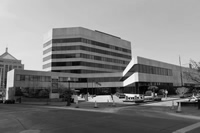 The terms international and brutalism best describe the style of this seven story building designed by Flad & Associates of Madison. Of the terms, the latter is derived from the French phrase "Breton Brut" meaning raw or rough art. Indeed, constructed of limestone covered concrete and glass, this structure embodies the unrefined. Since 1892, this location has been the site of financial institutions. The first was the German American Bank. Hostilities against Germany during WWI prompted a name change to American National Bank. In 1924, the building was redesigned in the Renaissance Revival form by Chicago architects Childs and Smith. The American National Bank merged with the Marathon County Bank in 1929 and with the First National Bank of Wausau in 1933. The name was changed to First American National Bank in 1964. Ten years later, the building was razed for the current structure.
The terms international and brutalism best describe the style of this seven story building designed by Flad & Associates of Madison. Of the terms, the latter is derived from the French phrase "Breton Brut" meaning raw or rough art. Indeed, constructed of limestone covered concrete and glass, this structure embodies the unrefined. Since 1892, this location has been the site of financial institutions. The first was the German American Bank. Hostilities against Germany during WWI prompted a name change to American National Bank. In 1924, the building was redesigned in the Renaissance Revival form by Chicago architects Childs and Smith. The American National Bank merged with the Marathon County Bank in 1929 and with the First National Bank of Wausau in 1933. The name was changed to First American National Bank in 1964. Ten years later, the building was razed for the current structure.
| |
| Dudley Tower 2005 - 2007 NW Corner of First and Scott |
[close] |
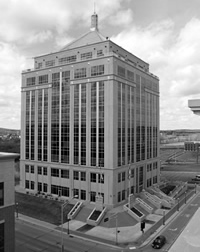 Eleven stories in height, this is the tallest building in Wausau, and an impressive addition to the downtown. Its presence represents not only the city's grandeur, but its future as a bustling and growing center of commerce. Built by Dudley Investments, the structure was designed by Mudrovich Architects of Wausau in the Post Modern style. Constructed of concrete, steel, and brick, it features a pyramid and small tower at the top, visible from many points in the surrounding areas.
Eleven stories in height, this is the tallest building in Wausau, and an impressive addition to the downtown. Its presence represents not only the city's grandeur, but its future as a bustling and growing center of commerce. Built by Dudley Investments, the structure was designed by Mudrovich Architects of Wausau in the Post Modern style. Constructed of concrete, steel, and brick, it features a pyramid and small tower at the top, visible from many points in the surrounding areas.
| |
| Wausau Club 1901 309 McClellan Street |
[close] |
| The prominent men of Wausau organized this club in 1901 as stated in the bylaws to "Promote the business interests of the city of Wausau and for the social enjoyment of its members." They did just that. Through the actions of members like Cyrus Yawkey and D.C. Everest, modern day Wausau began to take shape. Although women were initially prohibited, evidence suggests there were "ladies" days as early as 1911. The bylaws also banished alcohol and tobacco from the club and its many parties until the 1930's when prohibition was lifted. However, to what extent these rules were enforced is of question. The Wausau Club house, designed by architect J.H. Jeffers of Wausau, is Neo-Classical in design. Boasting the original ionic columns which support a classical pediment over the main entrance, additions were completed in 1912 and 1922 which created a kitchen, billiards hall, and a 16 room dormitory. Visited by such people as Hillary Rodham Clinton, the Wausau Club was, for many years, the place to belong to in Wausau. It closed its doors in 2005 as a result of decreased membership. The house has remained vacant since that time. | |
| Saint James Catholic Church 1911-1912 621 Second Street |
[close] |
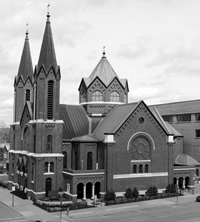 By the early 1900's the English language was gaining prevalence among immigrants to Wausau and the surrounding localities. Catholic Church sermons however, were only held in German at Saint Mary's and in Polish at Saint Michael's. Thus, in 1905 Saint James Parish was organized as the first English speaking parish in Wausau. By 1911 the congregation required a larger church, and funds were raised for its construction. Milwaukee architect Anton Dohmen incorporated both Gothic and Romanesque styles into the new church consisting of a central interior dome and identical exterior towers at the entrance. On September 21, 1911, two workers from Marks Brother's Construction Company were killed when the central dome collapsed. Building continued, and the church was completed in 1912.
By the early 1900's the English language was gaining prevalence among immigrants to Wausau and the surrounding localities. Catholic Church sermons however, were only held in German at Saint Mary's and in Polish at Saint Michael's. Thus, in 1905 Saint James Parish was organized as the first English speaking parish in Wausau. By 1911 the congregation required a larger church, and funds were raised for its construction. Milwaukee architect Anton Dohmen incorporated both Gothic and Romanesque styles into the new church consisting of a central interior dome and identical exterior towers at the entrance. On September 21, 1911, two workers from Marks Brother's Construction Company were killed when the central dome collapsed. Building continued, and the church was completed in 1912.
| |
| 600 Block 1890-1933 West Side Third Street |
[close] |
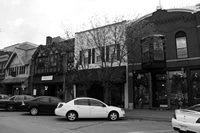 This portion of Wausau is perhaps the finest collection of late 19th and early 20th century commercial buildings in the area. It is the only example of an unbroken block face, representative of an earlier era of commercial architecture. These properties originally housed food stores, clothing shops, furniture dealers, and one of the first theatres: The Majestic. The styles of architecture represented here include Italianate, Queen Anne, Tudor Revival, and Commercial.
This portion of Wausau is perhaps the finest collection of late 19th and early 20th century commercial buildings in the area. It is the only example of an unbroken block face, representative of an earlier era of commercial architecture. These properties originally housed food stores, clothing shops, furniture dealers, and one of the first theatres: The Majestic. The styles of architecture represented here include Italianate, Queen Anne, Tudor Revival, and Commercial.
| |
| Saint Stephen Lutheran Church 1919 502 McClellan Street |
[close] |
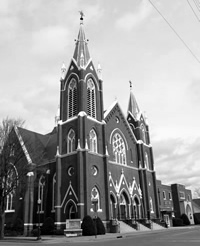 In 1881, Rev. Reinicke of Saint Paul's Evangelical Congregation left that parish with a group of parishioners and together formed this German Evangelical Lutheran Church. Their first building was an 1872 structure purchased from the Universalist Church in 1882. It was demolished in 1909 and in its place, designed by Milwaukee architect Anton Dohmen, stands the current Saint Stephen's Lutheran Church of 1910. Spires of unequal height, a triple arch entrance, and the many pinnacles result in a High Victorian Gothic citation.
In 1881, Rev. Reinicke of Saint Paul's Evangelical Congregation left that parish with a group of parishioners and together formed this German Evangelical Lutheran Church. Their first building was an 1872 structure purchased from the Universalist Church in 1882. It was demolished in 1909 and in its place, designed by Milwaukee architect Anton Dohmen, stands the current Saint Stephen's Lutheran Church of 1910. Spires of unequal height, a triple arch entrance, and the many pinnacles result in a High Victorian Gothic citation.
| |
| Employers Mutual 1940 407 Grant Street |
[close] |
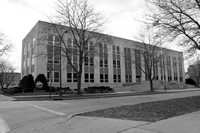 As Wausau entered the 20th century, the era of lumbering upon which the foundation of the city was built, and the economy depended, was at an end. The decline of lumbering proved to be a momentous shift in Wausau's industrial makeup. Perhaps the most influential factor in the transition from lumber to other business and industry was the formation of the Wausau Group in 1899. Their most successful innovation was Employers Mutual Liability Insurance formed on September 21, 1911 in response to the state workers compensation law passed that year. Over the next thirty years the company grew exponentially, and in 1940 a new building was constructed for their headquarters. Chicago architects Childs and Smith designed this Art Deco style structure built of limestone which features metal grillwork, art glass windows, and state seals at the roofline. The firm continued to expand through the purchase of insurance organizations across the country. This conglomeration came to be known as Wausau Insurance Companies. In 1967 they moved to the west side of Wausau, and the city purchased the building for a city hall.
As Wausau entered the 20th century, the era of lumbering upon which the foundation of the city was built, and the economy depended, was at an end. The decline of lumbering proved to be a momentous shift in Wausau's industrial makeup. Perhaps the most influential factor in the transition from lumber to other business and industry was the formation of the Wausau Group in 1899. Their most successful innovation was Employers Mutual Liability Insurance formed on September 21, 1911 in response to the state workers compensation law passed that year. Over the next thirty years the company grew exponentially, and in 1940 a new building was constructed for their headquarters. Chicago architects Childs and Smith designed this Art Deco style structure built of limestone which features metal grillwork, art glass windows, and state seals at the roofline. The firm continued to expand through the purchase of insurance organizations across the country. This conglomeration came to be known as Wausau Insurance Companies. In 1967 they moved to the west side of Wausau, and the city purchased the building for a city hall.
| |
| Episcopal Church of Saint John the Baptist 1867, 1914, 1922 330 McClellan Street |
[close] |
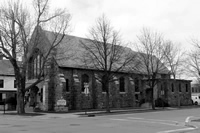 Walter McIndoe deeded land to the Episcopal Church of Saint John in the Wilderness led by Rev. Thomas Greene in 1858. Construction began that year, but went unfinished and a windstorm in 1863 destroyed what had been completed. After serving in the civil war, Rev. Greene resumed construction of the wood framed church which was completed in 1867. By 1914 the church was replaced with a new Tudor Revival structure built of Hatley field stone and designed by the Wausau firm Speer and Swarthout. The name was also updated to Saint John the Baptist, reflecting that Wausau at this time was no longer a wilderness. A stone stucco parish house designed by Oppenhamer and Obel of Wausau and Green bay was added on the west side of the property in 1922. The guild hall, connecting the church and the parish house, sheathed in stone, is the original 1867 building.
Walter McIndoe deeded land to the Episcopal Church of Saint John in the Wilderness led by Rev. Thomas Greene in 1858. Construction began that year, but went unfinished and a windstorm in 1863 destroyed what had been completed. After serving in the civil war, Rev. Greene resumed construction of the wood framed church which was completed in 1867. By 1914 the church was replaced with a new Tudor Revival structure built of Hatley field stone and designed by the Wausau firm Speer and Swarthout. The name was also updated to Saint John the Baptist, reflecting that Wausau at this time was no longer a wilderness. A stone stucco parish house designed by Oppenhamer and Obel of Wausau and Green bay was added on the west side of the property in 1922. The guild hall, connecting the church and the parish house, sheathed in stone, is the original 1867 building.
|
|
| First Presbyterian Church 1927 406 Grant Street |
[close] |
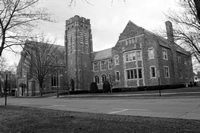 The first organizational meeting for this parish was held in 1858. For a time, the small congregation met in a variety of places around Wausau. However, in 1877 their first permanent church was erected at 206 McClellan Street. This structure was replaced in 1896 with a new church located on Grant Street. During the first two decades of the 20th century, the congregation grew rapidly and in 1927 the second church was replaced with this English Gothic style structure designed by Chicago architects Childs and Smith. It is faced with sandstone from a Stevens Point quarry, and trimmed with limestone.
The first organizational meeting for this parish was held in 1858. For a time, the small congregation met in a variety of places around Wausau. However, in 1877 their first permanent church was erected at 206 McClellan Street. This structure was replaced in 1896 with a new church located on Grant Street. During the first two decades of the 20th century, the congregation grew rapidly and in 1927 the second church was replaced with this English Gothic style structure designed by Chicago architects Childs and Smith. It is faced with sandstone from a Stevens Point quarry, and trimmed with limestone.
|
|
| YMCA 1962 707 Grant Street |
[close] |
| In 1891, forty seven years after the YMCA was first established in London, England, a branch was organized in Wausau. By 1893 their first secure home was built at the corner of Fourth and Scott Street and it accommodated some 270 members in 1894. By 1908 the YMCA moved to Grant Street, and the Wausau Record-Herald moved into the Scott Street building. The YMCA served the Wausau community during the mid 1900's with the mission: "To bring within its range an uplifting influence to the young men of the city and community." In 1962, with the support of A.P. Woodson, the current building was constructed. Designed by the local architect George E. Foster, the structure features beige brick on top, and Fond du Lac stone on the lower portions. | |
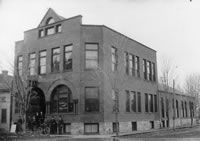 YMCA 1893 Scott Street  YMCA 1908 Grant Street |
|
| Yawkey House 1901 403 McIndoe Street |
[close] |
 This Classical Revival style house was built for Cyrus and Alice Yawkey. Cyrus, one of the most influential men in Wausau, was a lumber baron, an industrialist, and a philanthropist who contributed much to the city's industrial vitality. His house, designed by architects Van Ryn and De Gelleke of Milwaukee has ionic columns and a pedimented portico. In 1907 Chicago architect George W. Maher introduced an Arts and Crafts motif to the interior, sympathetic to the original design. A portion of the glass work was done by the Tiffany studios. Cyrus died in 1943, and Alice in 1953, at which time the house was deeded to the Marathon County Historical Society. The house was restored in 2007/08 to recreate the Yawkey House as it would have been after the 1907 remodeling.
This Classical Revival style house was built for Cyrus and Alice Yawkey. Cyrus, one of the most influential men in Wausau, was a lumber baron, an industrialist, and a philanthropist who contributed much to the city's industrial vitality. His house, designed by architects Van Ryn and De Gelleke of Milwaukee has ionic columns and a pedimented portico. In 1907 Chicago architect George W. Maher introduced an Arts and Crafts motif to the interior, sympathetic to the original design. A portion of the glass work was done by the Tiffany studios. Cyrus died in 1943, and Alice in 1953, at which time the house was deeded to the Marathon County Historical Society. The house was restored in 2007/08 to recreate the Yawkey House as it would have been after the 1907 remodeling.
|
|
| A.P. And Leigh (Yawkey) Woodson House 1914 410 McIndoe Street |
[close] |
 In 1911, Leigh, the daughter of Cyrus and Alice Yawkey, married A.P. Woodson. Together they moved here from Kansas City in 1914 and built this house across from her parents' home. Designed by Chicago architect George W. Maher in the Prairie School style, it has a horizontally-oriented low pitched roof, wide eaves, and ribbon windows. Woodson, like his father in law was an active business leader and a philanthropist in Wausau. Following her parents deaths, Leigh and A.P. moved to the east side of the city and sold the house to the Immanuel Baptist Church. In 1995 the Marathon County Historical Society purchased the residence. Now known as the Woodson History Center, the building is home to the Marathon County Historical Society free exhibits, research library and offices.
In 1911, Leigh, the daughter of Cyrus and Alice Yawkey, married A.P. Woodson. Together they moved here from Kansas City in 1914 and built this house across from her parents' home. Designed by Chicago architect George W. Maher in the Prairie School style, it has a horizontally-oriented low pitched roof, wide eaves, and ribbon windows. Woodson, like his father in law was an active business leader and a philanthropist in Wausau. Following her parents deaths, Leigh and A.P. moved to the east side of the city and sold the house to the Immanuel Baptist Church. In 1995 the Marathon County Historical Society purchased the residence. Now known as the Woodson History Center, the building is home to the Marathon County Historical Society free exhibits, research library and offices.
|
|
| Barker Stewart Island
|
[close] |
| Originally called McIndoe Island, this site is home to the only remnants of a 19th century sawmill in the city of Wausau. Clark Johnson and Company built the first mill here in 1881 and operated it until 1887 when C.C. Barker and H.C. Stewart purchased the firm. At this time, much of the white pine forest crop was depleted - a result of intense lumbering in the mid to late 1800's. Therefore, the Barker Stewart Mill cut the remaining hemlock forest and was the county's leading producer of that wood. Operations were terminated in 1915 and the island now serves as a park complete with walking trails, bridges, and interpretative storyboards. | |

